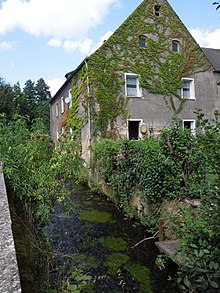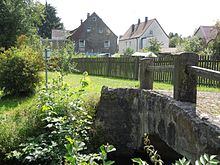Hammer Philippsburg

The listed Hammer Philippsburg (or Hammer Rosenberg , as it was previously called) is a former hammer mill in the Upper Palatinate town of Sulzbach-Rosenberg in the Amberg-Sulzbach district of Bavaria (Hammerphilippsburg 1 a). The Schienhammer was powered by the water power of a canal of the Rosenbach .
history
Rosenberg was one of the imperial estates around Sulzbach. In 1307 King Albrecht transfers the "castrum Rosenberg", which formerly belonged to Count Gebhard von Hirschberg , to the Wittelsbach dukes Ludwig and Rudolf . In the land register of the Lengenfeld vicarage from 1326, Rosenberg appears as a ducal land registry office.
In 1366 Count Palatine Ruprecht the Elder gave Friedrich the Castner zu Rosenberg the right to build an iron hammer. In 1387 this hammer was in the hands of the Nuremberg patrician Peter Behaim, who was also a member of the Upper Palatinate Hammer Association .
In 1405 Hans Kotterlein († 1412), citizen of Amberg , received the hammer as a fief. After his death, his son Erhart († 1420) received the hammer, the mill and the pond. Half of the property came from his Wirwe and the two daughters he left behind to Heymeram Alhard (citizen of Amberg) and Ulrich Löneysen (citizen of Sulzbach). After that, the factory in which bar iron was produced was mostly in the hands of Sulzbacher mountain lords, some of whom were local hammer masters: the Sulzbacher Erasmus Sauerzapf bought half the hammer from Haymran Alhard in 1427, and in 1435 he acquired the other half from Ulrich Löneysen. Erasmus Sauerzapf also had a tin hammer built here; He was probably thinking of having the sheets tinned here too, since he had acquired a mining right for tin ore near Tröstau from the Margrave of Bayreuth . In 1450 Duke Albrecht renews the privileges of the hammer at Rosenberg to Jakob Sauerzapf ; this included criminal jurisdiction over the workers. In 1515 these rights were confirmed to Balthasar Doles (whose wife Agnes was a Sauerzapf), who probably had acquired the hammer shortly before. His successor was Melchior Dolores († 1563), who was also councilor of Sulzbach; A tombstone from 1563 has been preserved from him in the Protestant parish church in Rosenberg. Franz Doles received a renewal of privileges for the hammer mill in 1571. In 1605 Hans Doles was enfeoffed with the hammer, and in 1616 his sons Hans Wilhelm and Hans Sebastian were named as owners. In 1630 there is still a reference to "Doles' children at Rosenberg". Debt of the hammer mill began as early as 1610. From 1633 Franz Busen owned the hammer mill, which was badly damaged due to the effects of the war, and had it rebuilt. The blast furnace including the hammer was in operation until 1783, but without regaining its former importance.
In the 18th century, the hammer mill was used as an art mill ( faience factory) for around 20 years . From 1789 the property was used as a paper mill.
The name Hammer Philippsburg (so called from 1660) goes back to Count Palatine Philipp Florinus († 1703), a brother of Duke Christian August zu Sulzbach , who had lived here for a while.
The Hammer was inhabited by the Decker family until the end. The last Günter Friedrich Decker (born January 25, 1963) to be born in the manor house now lives near Munich. On January 25, 1967, the mansion collapsed to the west of the house. On the remaining one square meter of floor space on the first floor, the landlord Franz Decker was sitting on a chair by the window and his legs hung into space. He was saved through the window by the fire department. The rest of the family was late at the birthday party of grandson Günter. That same night the looting of art and valuables began. The remaining house front was torn down in 1968.
Hammer Philippsburg today
The former hammer house is a two-story, plastered solid building with a gable roof . To the northeast there is an extension with a lower attic. The building is partially equipped with arched windows. The core of the building (foundation walls) dates back to the 16th century. On the eaves side there is an embedded coat of arms stone with the year "1578".
literature
- Hans Nicol: The hammer Rosenberg near Sulzbach. Die Oberpfalz , Volume 60, 1972, pp. 38-41.
- Franz Michael Ress: Buildings, monuments and foundations of German ironworkers . Written on behalf of the Association of German Ironworkers . Verlag Stahleisen, Düsseldorf 1960, DNB 453998070 , p. 152 .
- Max Piendl (1957): Duchy of Sulzbach, District Judge Sulzbach . (= Historical Atlas of Bavaria, Altbayern Series I, Issue 10). Commission for Bavarian State History. Michael Lassleben Publishing House, Munich (p. 55f).
Individual evidence
- ↑ This dating from the Historical Atlas of Bavaria is disputed after Franz Michael Ress, who gives the year 1350 as the founding date for the hammer.
Coordinates: 49 ° 29 ′ 27.1 ″ N , 11 ° 46 ′ 42.9 ″ E

